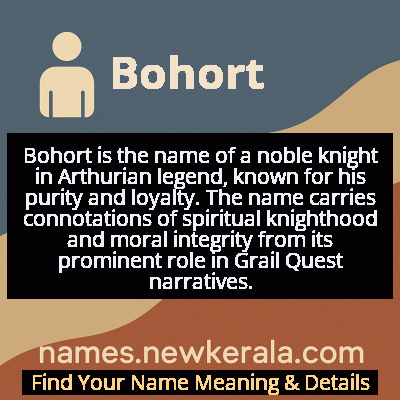Bohort Name Meaning & Details
Origin, Popularity, Numerology Analysis & Name Meaning of Bohort
Discover the origin, meaning, and cultural significance of the name BOHORT. Delve into its historical roots and explore the lasting impact it has had on communities and traditions.
Name
Bohort
Gender
Male
Origin
Arthurian
Lucky Number
6
Meaning of the Name - Bohort
Bohort is the name of a noble knight in Arthurian legend, known for his purity and loyalty. The name carries connotations of spiritual knighthood and moral integrity from its prominent role in Grail Quest narratives.
Bohort - Complete Numerology Analysis
Your Numerology Number
Based on Pythagorean Numerology System
Ruling Planet
Venus
Positive Nature
Harmonious, responsible, caring, and artistic.
Negative Traits
Overly idealistic, superficial, possessive, or jealous.
Lucky Colours
Pink, turquoise.
Lucky Days
Friday.
Lucky Stones
Diamond, turquoise.
Harmony Numbers
2, 3, 9.
Best Suited Professions
Artists, musicians, teachers, healthcare workers.
What People Like About You
Warmth, nurturing nature, artistic flair.
Famous People Named Bohort
Sir Bohort
Knight of the Round Table
One of the three greatest knights who achieved the Holy Grail quest
Bohort de Ganis
Arthurian Knight
Known for his purity and loyalty, cousin to Lancelot
Bohort l'Essillé
Literary Character
Prominent figure in the Vulgate Cycle and Post-Vulgate Arthurian romances
Name Variations & International Equivalents
Click on blue names to explore their detailed meanings. Gray names with will be available soon.
Cultural & Historical Significance
Throughout Arthurian literature, Bohort serves as a moral compass among the knights, often mediating conflicts and providing wise counsel. His complex relationship with Lancelot—balancing family loyalty with moral principles—illustrates the medieval ideal of friendship tested by higher duties. The character's evolution from the early French romances through Malory's Le Morte d'Arthur demonstrates changing medieval attitudes toward chivalry, spirituality, and personal integrity. Bohort's enduring presence in Arthurian tradition underscores the lasting appeal of characters who embody both martial excellence and deep spiritual commitment.
Extended Personality Analysis
Bohort is characterized by his exceptional moral integrity, deep loyalty, and spiritual purity. He embodies the ideal of the 'pure knight' who consistently chooses ethical principles over personal gain or emotional attachments. His personality is marked by thoughtful deliberation—he rarely acts impulsively and carefully weighs the consequences of his actions. This contemplative nature sometimes puts him at odds with more passionate knights like his cousin Lancelot, yet it serves him well in spiritual quests where discernment is crucial.
Bohort demonstrates remarkable emotional resilience, maintaining his principles even when faced with heartbreaking choices between family loyalty and higher moral duties. His compassion for others, combined with his unwavering commitment to justice, makes him both a respected warrior and a trusted counselor among Arthur's knights. Unlike many of his peers driven by passion or ambition, Bohort's motivations stem from a deep sense of duty and spiritual calling. This makes him particularly suited for the Grail Quest, where his purity of heart and steadfast morality enable his ultimate success. Despite his martial prowess, Bohort's greatest strength lies in his spiritual and moral fortitude, which ultimately defines his legacy in Arthurian tradition.
Modern Usage & Popularity
In contemporary times, Bohort remains primarily a literary and historical name rather than a common given name. Its usage is almost exclusively confined to Arthurian enthusiasts, historical reenactors, and parents seeking unique names with medieval resonance. The name appears occasionally in fantasy literature and gaming communities, particularly in role-playing games and Arthurian-inspired fiction. While it hasn't gained mainstream popularity, it maintains a niche appeal among those appreciating its rich literary heritage and distinctive sound. The simplified variation 'Bors' sees slightly more frequent use, though both remain quite rare in modern naming practices outside specialized contexts. Recent years have seen a minor resurgence in Arthurian names, but Bohort continues to be among the less commonly adopted compared to names like Arthur, Lancelot, or Gawain.
Symbolic & Spiritual Meanings
Bohort symbolizes the ideal of spiritual knighthood and moral integrity in the face of complex challenges. He represents the archetype of the 'pure warrior' whose strength comes not merely from physical prowess but from unwavering ethical principles and spiritual devotion. His character embodies the medieval concept of balancing earthly duties with heavenly aspirations—the struggle to maintain loyalty to family and lord while pursuing higher spiritual goals. Bohort's successful Grail Quest completion makes him a symbol of redemption and spiritual achievement, representing the possibility of attaining divine grace through persistent virtue. His narrative serves as a powerful metaphor for the human capacity to navigate moral complexity while maintaining core values, making him an enduring symbol of ethical consistency in literature and cultural tradition.

